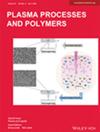利用常压冷等离子体对氮化硼纳米管涂层聚酰亚胺薄膜进行多功能表面处理
IF 2.9
3区 物理与天体物理
Q2 PHYSICS, APPLIED
引用次数: 0
摘要
使用常压冷等离子体在露天处理涂有和未涂有氮化硼纳米管(BNT)的聚酰亚胺(PI)表面。这种处理方法提高了 PI 表面的润湿性(以水接触角从 68° 减小到 16° 来衡量),使 BNNT 涂层更加均匀,表面附着力得到改善。等离子处理 BNNT 涂层 PI 表面还能有效去除用于 BNNT 在水中分散的残留聚合物表面活性剂,由于等离子和 PI 表面温度分别为 350 和 300 K,因此不会造成任何热损伤。等离子体中的活性氧(如羟基分子和氧原子)在这些过程中发挥了重要作用。常压等离子体可用于在热弱聚合物基底上涂覆 BNNTs 的各种应用中。本文章由计算机程序翻译,如有差异,请以英文原文为准。
Multifunctional surface treatment of boron nitride nanotube‐coated polyimide films with atmospheric‐pressure cold plasma
Polyimide (PI) surfaces coated with and without boron nitride nanotubes (BNNTs) were treated using an atmospheric‐pressure cold plasma in open air. This treatment increased the surface wettability of the PI, measured by a decrease in water contact angle from 68° to 16°, resulting in a more uniform BNNT coating and improved surface adhesion. The plasma treatment of the BNNT‐coated PI surfaces also effectively removed residual polymer surfactants used for BNNT dispersion in water, without causing any thermal damage due to the low plasma and PI's surface temperatures of 350 and 300 K, respectively. The reactive oxygen species in the plasma, such as hydroxyl molecules and oxygen atoms, played an important role in these processes. Atmospheric‐pressure plasma can be employed in various applications in which thermally weak polymer‐based substrates are coated with BNNTs.
求助全文
通过发布文献求助,成功后即可免费获取论文全文。
去求助
来源期刊

Plasma Processes and Polymers
物理-高分子科学
CiteScore
6.60
自引率
11.40%
发文量
150
审稿时长
3 months
期刊介绍:
Plasma Processes & Polymers focuses on the interdisciplinary field of low temperature plasma science, covering both experimental and theoretical aspects of fundamental and applied research in materials science, physics, chemistry and engineering in the area of plasma sources and plasma-based treatments.
 求助内容:
求助内容: 应助结果提醒方式:
应助结果提醒方式:


